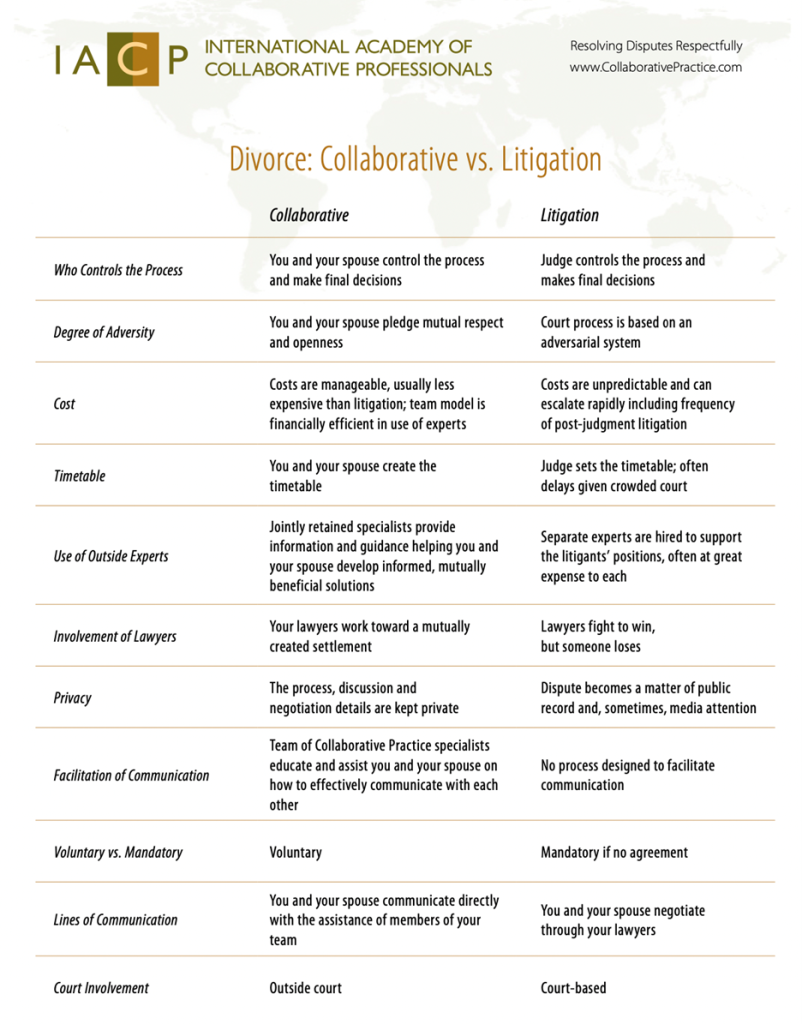The Collaborative Process
An Option to Full-Blown Litigation
This article is the first of a multi-part series wherein I will provide the broad strokes of the Collaborative Process and continue with examples of engagements wherein the process has been used (both successfully and unsuccessfully).
For the first two years of my practice (2013 through 2015), I worked almost exclusively in pre-nuptial agreements and divorce, mostly in business valuation services and litigation support. These first two years, as is likely the case for many sole proprietors, were from a professional perspective, the most significant for me and the future operations of my company. It was then that I discovered that I did not want to provide litigation support service that would require repeated court appearances and Daubert challenges. In those first two years, I found that I enjoyed helping people, and through these experiences, I ultimately discovered a way wherein I could help my clients AND stay out of the courtroom‚ÄĒThe Collaborative Process. Although the Collaborative Process (‚ÄúProcess‚ÄĚ) is not for everyone and is not a panacea for the woes of a divorce or any less expensive than a litigated divorce, I have still seen the Process work significantly better for many of my clients than that of a traditional divorce proceeding. Not only does a Collaborative divorce keep confidential documentation out of public court filings, but it also eliminates the potential of having the divorce on display in a courtroom. This article is the first of a multi-part series wherein I will provide the broad strokes of the Collaborative Process and continue with examples of engagements wherein the Process has been used (both successfully and unsuccessfully). ¬†
When people come together in a union of marriage, they are often subconsciously seeing their partner as a projection of a better version of oneself‚ÄĒoften referred to as the ‚Äúhoneymoon phase‚ÄĚ.[1] Over time, these positive projections can turn negative, compounded and stemming from unresolved childhood needs, and the union is broken. It is an unfortunate reality that happens time and again, which is why the divorce rate for first time marriages in the United States is between 40% and 50%, second marriages 60%, and third marriages 73%.[2] Despite healthy doses of self-love, it is common that defense mechanisms are raised when separation and/or divorce discussions arise. The sequence of events leading up to a divorce is often a nasty recipe wherein a spouse can feel as though the only retaliation possible is obtained through an attorney in the form of subjective advocacy (include children in the mix and a new generation of childhood trauma is created). When children are involved, how is it going to be in the future at shared life events (marriage of children, birth of grandchildren, school events, funerals) when the final involvement between the clients is one filled with vitriol acrimony. Wouldn‚Äôt it be great if it were possible to avoid, or at least mitigate, the side effects of this counterproductive emotional roller coaster? In the following article, I will detail alternative options to the traditional litigative divorce process, specifically Collaborative Divorce, and why more and more divorce professionals are choosing to work exclusively in non-litigation dispute resolution. ¬†¬†
Prior to starting my own practice, I worked in the merger and acquisitions departments for larger firms based in New York City (Merrill Lynch, Lehman Brothers). I worked there as a financial analyst and never on a 1:1 basis with clients. So, working on divorce cases directly with the party(s) and attorney(s) was a new world to me, one in which I found the hours to be long, filled with emotion (predominately from the parties, sometimes with the attorneys as well), and stressful. Personally, I did not see a future in this field if the work were all of this sort, yet being that I was living in a quiet, tiny, retirement town in Florida at this point, I had to take the work that was available (e.g., divorce). Thankfully, as I was heading into my third year of practicing solo, I was introduced through a peer to the concept referred to as the ‚ÄúCollaborative Process‚ÄĚ and a group of ‚ÄúCollaborative professionals‚ÄĚ[3] who were trained in the Process and met on a regular basis with the hopes of obtaining more Collaborative Process divorce work. Within a short period of time, I completed the ‚ÄúBasic & Continuing Education 3-Day Collaborative Divorce Training‚ÄĚ, led by the Interdisciplinary Collaborative Divorce Trainers.[4] The training is¬† necessary to work as a Collaborative expert. The experience was fun and educational, and revealed a world in almost complete opposition to the one I had been enmeshed in over the recent years.
After I completed the basic training, I worked as a board member for the local collaborative group, Collaborative Professionals of Southwest Florida, served as the treasurer for the Florida Academy of Collaborative Professionals (FACP), oversaw/orchestrated local trainings,[5] worked as a collaborative expert on pro bono cases, obtained my state mediator certification and continually educated new clients and other professionals about the process. During my time with the FACP, the Collaborative Law Process in Family Law was recognized by the state court system and codified as Rule 4-1.19. Under the ‚ÄúComment‚ÄĚ section of Rule 4-1.19 the following text is put forth which beautifully sums up the Process:
‚ÄúThe collaborative law process involves the nonadversarial resolution of disputes through voluntary settlement procedures. Florida statutes and court rules permit collaborative law to resolve disputes in family law. Lawyers engaging in the collaborative law process in family law matters must comply with legislative and court requirements regarding the process. As part of this nonadversarial and voluntary resolution of disputes, lawyers who engage in the collaborative law process in a family law matter, and any other lawyers in that lawyer’s firm, may not afterwards represent any party in any related proceeding except to request that a court approve the settlement reached during the collaborative law process or in specified emergency situations in accordance with family law court rules.‚ÄĚ
As clearly noted, the ‚Äúrestrictive‚ÄĚ part of entering into a Collaborative contract is the fact that if the process is not successful and the client wants ‚Äútheir day in court‚ÄĚ, the client is not able to continue use of the retained Collaborative counsel, or their firm, and must start the marital dissolution process over using new counsel. In doing so, the client is ultimately choosing the potential to have their future, and the future of their children, in a judge‚Äôs hand. ¬†¬†¬†
The International Academy of Collaborative Professionals (IACP) provides a plethora of useful information on the Process, one document[6] that I use to swiftly describe the difference between a Collaborative divorce and a litigated divorce is captured below for reference:
In addition to the actionable differences between litigation and Collaborative divorce process are terminology differences. At a recent advanced Collaborative training event held in Tampa, Florida and hosted by The Florida Collaborative Trainers, the presenters went over ‚ÄúLitigation Language‚ÄĚ as compared to ‚ÄúCollaboration Language‚ÄĚ, detailed as follows:
Litigation Language¬†¬†¬†¬†¬†¬†¬†¬†¬†¬†¬†¬†¬†¬†¬†¬†¬†¬†¬†¬†¬†¬†¬†¬†¬†¬†¬†¬†¬† –¬†¬†¬†¬†¬†¬†¬†¬†¬†¬†¬†¬†¬†¬†¬†¬†¬†¬†¬†¬†¬†¬† Collaborative Language
Opposing counsel                                                          My colleague
My client                                                                      Name of client
You should                                                                    What would it look like if…
As your attorney, I will                                                  We will work together as a team
I will provide the answers                                              We will brainstorm ideas…
Child custody/visitation                                                 Co-parenting plan
I can get you…                                                             As a team, we will help you…
The law says…                                                             The law is only one option
The advanced training went on to note the Financial Collaborative Law Professional Responsibilities (examples of which are noted below):
- Maintain a neutral role
- Adhere to the rules and protocols of the collaborative agreement
- Transparency of relevant information with the ‚Äúteam‚ÄĚ
- Timely service production and response time
- Continual updates to the team
- Think outside the box for the betterment of the parties
- Empower the less informed spouse
- Provides information/alternatives around innovative solutions to financial terms
It is easy to see how the Collaborative Process would be appealing to individuals in need of legal services and experts assisting these individuals, but as with anything, there are considerations that need to be accounted for that are explained most clearly through example. In the next installment, we will dive into the Collaborative Process from a collaboratively trained expert’s point of view through the utilization of real-world (vetted) instances in which the Process has been used. Many financial experts can commiserate with the point of view regarding litigation presented herein, one of which is my peer, David Goodman, MBA, CPA, CVA.[7] David will be co-authoring the next QuickRead article in this series, providing his professional Collaborative Law Process experiences. We look forward to working together in conveying the benefits and drawbacks of the Collaborative Law Process through recounting our firsthand encounters. I will leave you with a quote that I feel adequately sums up the Collaborative Law Process:
‚ÄúThe way a team plays as a whole determines its success. You may have the greatest bunch of individual stars in the world, but if they don‚Äôt play together, the club won‚Äôt be worth a dime.‚ÄĚ – Babe Ruth
[1] David completed the Massachusetts Collaborative Law Council training in 2013 and served as the Council’s treasurer for a period. He works as a financial neutral on collaborative and non-collaborative divorce cases, mostly as a business valuation expert, but also on cases with more complex financial and tax issues.
[1] https://health.clevelandclinic.org/what-is-the-honeymoon-phase/#:~:text=This%20feeling%20of%20euphoria%20is,%2C%20in%20some%20cases%2C%20years
[2] https://divorce.com/blog/divorce-statistics/
[3] https://collaborativepros.com
[4] For further information on training programs currently available contact the IACP https://www.collaborativepractice.com/event/basic-interdisciplinary-collaborative-practice-training-1.
[5] Utilizing the Tampa Bay Collaborative Trainers https://tampabaycollaborativetrainers.com
[6] https://www.collaborativepractice.com/sites/default/files/CP-KnowledgeKit.pdf
[7] David completed the Massachusetts Collaborative Law Council training in 2013 and served as the Council’s treasurer for a period. He works as a financial neutral on collaborative and non-collaborative divorce cases, mostly as a business valuation expert, but also on cases with more complex financial and tax issues.
Tricia Garthoeffner, ABV, CVA, MAFF, EA, MAcc, is the founder and managing member of Anchor Business Valuations & Financial Services, LLC (ABVFS). She has over 15 years of experience in providing business valuation and consulting services. As a previous holder of the series 7, 62, 63, and 72 licenses, and current Florida licensed Sales Associate, she also has the financial services and merger and acquisition background (~10 years on Wall Street in investment banking and private equity/hedge fund) needed to maintain an active presence in M&A consulting.
Ms. Garthoeffner was recently nominated (2022) as the Chair for NACVA’s Standards Board, after serving as the Vice-Chair (2021). She is a past Florida state chapter president for NACVA and a current teacher of the NACVA CVA exam (credentialing program for expert candidates nationwide), a past treasurer of the Florida Academy of Collaborative Professionals and a past Vice-President, and current member, of the Southwest Florida Chapter of Collaborative Professionals. Most recently, she was appointed to the social media task force team of Pocket Experts Solutions.
Ms. Garthoeffner can be contacted at (239) 919-3092 or by e-mail to info@AnchorBVFS.com.











